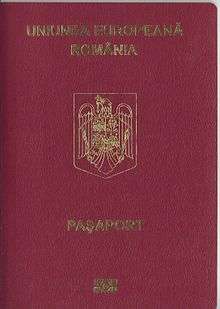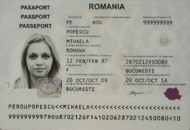Romanian passport
| Romanian passport | |
|---|---|
 The front cover of a contemporary Romanian biometric passport (since 2011) | |
 The data page of a contemporary Romanian biometric passport | |
| Issued by |
|
| Type of document | Passport |
| Eligibility requirements | Romanian citizenship |
Romanian passport is an international travel document issued to nationals of Romania, and may also serve as proof of Romanian citizenship. Besides enabling the bearer to travel internationally and serving as indication of Romanian citizenship, the passport facilitates the process of securing assistance from Romanian consular officials abroad or other European Union member states in case a Romanian consular is absent, if needed.
According to the 2014 Visa Restrictions Index, Romanian citizens can visit 148 countries without a visa or with a visa granted on arrival. Romanian citizens can live and work in any country within the EU as a result of the right of free movement and residence granted in Article 21 of the EU Treaty.[1]
Every Romanian citizen is also a citizen of the European Union. The passport, along with the national identity card allows for free rights of movement and residence in any of the states of the European Union and European Economic Area.
The types of passports are:
- Diplomatic
- Business
- Simple (biometric): valid for 5 years (3 years for minors under 12 years of age)
- Simple (temporary): valid for 1 year, issued as an emergency travel document.
Romania has begun issuing its biometric passport on 31 December 2008.
History

The term for passport – name still in use today, which describe the general document travel under which Romanian travellers can travel beyond the borders of the Danube and the Habsburg Empire – first appears regulated in the Organic Regulations, which came into force in 1830 in Moldova and 1831 in Romanian Country. According to historical data, travellers were required to show a passport at the border of Wallachia both the consulate, and ravaged by road. Foreigners arrived in the country had to have a visa Romanian consulate, which was present at Agie, where passports are then released which could move anywhere in the country.[2]
A historic milestone in the evolution of Romanian passport was the promulgation, on 19 March 1912 by King Carol I, the first modern laws related to passports. Thus, the "Law on paspoartelor" Romanian state introduced the first general principles regarding passports and border crossing mandatory for authorities and citizens. The law was structured XI articles, passport thus becoming national legal instruments needed to be used when Romanians travelling abroad.
Liberate the Ministry of Interior and county prefects, "paspoartele" were issued in the name of King and had small portable card format "size 9 cm (4 in) 13 cm (5 in), is composed of 20 pages numbered." Each page had framed, a fund composed of national reasons, in light lilac colour, making apparent to stand above the coat of arms and having the word "Romania", and below the word "Pasport".[2]
Evolution of the passports continued in the period before and during the Second World War, when new types of ordinary passports, service and diplomatic were introduced, some distinguished by a special technique of fastening (sticking, Stitching) tabs of covers, which create a fan effect.[2]
Romanian People's Republic
Political and social changes occurring with the proclamation on 30 December 1947 of the Romanian People's Republic led authorities at the time to introduce into circulation passports with a new name of the state and a new heraldic.
Modern period
After the Romanian Revolution of 1989 and the collapse of the communist bloc Romanian authorities opened the country's borders, which led to an exodus of Romanian citizens wishing to travel abroad.[2]
It was necessary that the organs with attributions issuing passports to circulate the Romanian travel documents to be aligned with international standards to be similar to those issued by other states. Thus, in accordance with Government Decision no. 757 of 30 December 1993, starting June 1994, was introduced into circulation a new model of Romanian passport simple first Romanian travel document issued in accordance with international standards.[2]
On 21 January 2002, the Romanian government introduced a new type of passport in a decision taken due to exacerbation of migration and the need to ensure greater security of documents, as in use European and international level at the time.
Like most countries in Southeast Europe, Romania has committed itself in the process of accession to the EU, assuming certain responsibilities to comply, just as member countries, rules and requirements designed to compete in a safe lifestyle, this signifying and harmonisation of legislation and issuing travel documents to comply with international and European. The adoption on 20 July 2005, Law no. 248 on the free movement of Romanian citizens abroad held in conditions that Romanian citizens could exercise their right of free movement abroad and the limits of this right.
Application
The Ministry of Interior and Administrative Reform, through the Community Public Service of Issuance and Registration of Simple Passports (Serviciul Public Comunitar pentru Eliberarea şi Evidenţa Paşapoartelor Simple), is responsible for the issuance and renewal of Romanian passports.
Description
Regular Romanian EU passports are burgundy red in colour, with the Romania Coat of Arms emblazoned in the centre of the front cover. The words "European Union", "Romania", and "passport" are inscribed above and below the coat of arms (in Romanian). The information page identifying the bearer and the issuing authority is on the first page, not numbered (the Romanian passport contains 32 pages, information written on the 32nd page of the passport). On the last page, the bearer fills in information regarding contact person (persons) in case of emergency. On the third cover (the inner back cover) there are instructions for the bearer how to use and how not to use the passport.
The carte de identitate can now be used to travel within the European Union.
Identity Information Page
The Romanian Passport includes the following data:
- Photo of Passport Holder
- Type (P)
- Country Code (ROU)
- Passport No.
- Surname
- Given Names
- Nationality
- Date of Birth
- Personal No.
- Sex
- Place of Birth
- Date of Issue
- Date of Expiry
- Authority
- Holder's Signature
The information page ends with the Machine Readable Zone. The data page/information page is printed in Romanian, English and French.
Visa requirements

As of 2015, Romanian citizens had visa-free or visa on arrival access to 149 countries and territories, thus ranking the Romanian passport 19th in the world (second lowest ranking of all EU member states; Croatia has the lowest ranking of all EU member states).[3]
Foreign travel statistics
According to the statistics these are the numbers of Romanian visitors to various countries per annum in 2014:
| Foreign travel statistics | |
|---|---|
| Destination | Number of visitors |
| |
264,704 |
| |
41,630 |
| |
1,439,853 |
| |
63,000 |
| |
18,161 |
| |
278,873 |
| |
230,436 |
| |
7,142 |
| |
22,624 |
| |
16,112 |
| |
1,188 |
| |
38,112 |
| |
30,886 |
| |
36,959 |
| |
942 |
| |
22,756 |
| |
25,730 |
| |
426,585 |
| |
584,774 |
| |
471,411 |
| |
63,051 |
Gallery of historic images

Kingdom of Romania
Romanian Passport (cca. 1922 - 1947).jpg)
Socialist Republic Romanian Passport (issued in August 1987) 
Pre-EU
Romanian Passport (non-biometric) (cca. 2002 - 2008)
EU Romanian Biometric Passport (2009 - 2010)
See also
- Visa requirements for Romanian citizens
- Visa policy of Romania
- Passports of the European Union
- Romanian identity card
- Romanian nationality law
References
- ↑ Treaty on the Function of the European Union (consolidated version)
- 1 2 3 4 5 REPERE EVOLUTIVE ALE ISTORIEI PASAPOARTELOR ROMANESTI
- ↑
- ↑ Tourismus in Österreich 2014
- ↑ Tourisme selon pays de provenance 2014
- ↑ ARRIVALS OF VISIORS FROM ABROAD TO BULGARIA BY MONTHS AND BY COUNTRY OF ORIGIN IN 2014
- ↑ Tourism in Figures 2014
- ↑ ARRIVALS OF TOURISTS BY COUNTRY OF USUAL RESIDENCE
- ↑
- ↑ Tourism in Hungary 2014
- ↑ Statistical review: Transport, tourism and other services
- ↑
- ↑ Table 4. Foreign tourist arrivals and overnight stays by countries, 2014
- ↑ Immigration New Zealand statistics – A1b – Arrivals by month
- ↑ Overnight stays in accommodation establishments in 2014 (PDF file, direct download 8.75 MB), Główny Urząd Statystyczny (Central Statistical Office), pp. 174–177 / 254. Warsaw 2015.
- ↑ http://www.russiatourism.ru/contents/statistika/statisticheskie-pokazateli-vzaimnykh-poezdok-grazhdan-rossiyskoy-federatsii-i-grazhdan-inostrannykh-gosudarstv/strany-lidiruyushchie-po-kolichestvu-pribytiy-na-territoriyu-rossiyskoy-federatsii/
- ↑ Statistical Yearbook of the Republic of Serbia – Tourism, 2015
- ↑
- ↑
- ↑ Slovenian Tourism in Numbers 2014
- ↑ Border Statistics 2014
- ↑ Foreign citizens who visited Ukraine in 2014 year, by countries
- ↑
- ↑
- Official site of the issuing authority
- Delta Air Lines – Visa & Passport Information
- Saint Lucia Tourist Site of Frequently Asked Questions: Do I need a Visa to Enter Saint Lucia?
- Visa Information For Foreigners – Republic of Turkey Ministry of Foreign Affairs
External links
| Wikimedia Commons has media related to Passports of Romania. |